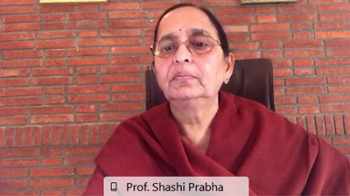On 26 November, VIF organized a lecture on ‘Introduction to Vedic Literature: The Upanishads’ by Prof Shashi Prabha Kumar, Dean, Sri Sankaracharya Sanskrit Mahavidyalaya, Bharatiya Vidya Bhavan. This is part of the VIF Lecture Series ‘Philosophy for Beginners’.
The speaker began by highlighting the importance of the Vedic literature—the world’s oldest repository of human knowledge. The word ‘Veda’ is derived from the Sanskrit root ‘vid’ which means ‘to know’. She emphasized the universal nature of the Vedas and the eternal appeal of its message like calling human beings the “children of immortal bliss” (amritasya putra). She discussed the nature of the Vedic literature. It is apaurusheya, that is, the origin of the Vedas is not in the human mind. The Vedic hymns were revealed to the rishis (seers) of yore, who merely recorded them. It is thus also known as shruti, that which is heard directly. A rishi is a person who is mantradrashta, that is somebody who directly perceives the sacred mantras. Vedic literature was also oral in nature; it was committed to writing much later. In earlier times, it was transmitted from one generation to another by oral recitation.

Prof Kumar then discussed the four Vedas—Rik, Sama, Yajur and Atharva; the organization of the each Veda into Samhitas (the oldest part), Brahmanas (portion dealing with rituals), and Aranyakas (part dealing with contemplation); the number of mandalas, suktas etc.; the different Vedic shakhas; and so on. She then discussed the Upanishads, which constitute Vedanta, the end portion and the essence of the Vedas. She first explained the term ‘Upanishad’ as ‘knowledge that is to be acquired by sitting near the guru’. The subject matter of the Upanishads is transcendental knowledge, and such knowledge requires two entities—the seer and the seeker. The seer or rishi is one who has direct realization of Truth; the seeker is one who is seeking this knowledge. The knowledge in the Upanishads is imparted by the seer and received by the seeker. There is this unique concept of the Adhikari or one who is suitable or eligible for knowledge. The Indian tradition is very clear about the pre-requisite qualities of a teacher as well as a seeker.
Upanishads are many and their composition continued till later times. But the most authentic Upanishads are ten or 11 only (some scholars list 12 or 13 as well). The ten principal Upanishads are Chhandogya, Brihadaranyaka, Isha, Kena, Katha, Prasna, Mandukya, Mundaka, Aitareya, Taittiriya, on which the 8th century philosopher Adi Sankaracharya has written commentaries. The commentary on the Svetashvatara Upanishad which is attributed to Sankara may not have been written by him, but Svetashvatara is often counted among the principal Upanishads.

Acharya Sayana who lived in the 14th century Vijaynagara kingdom wrote commentary on the Vedas. Apart from him there were at least 20 other ancient commentators on the Vedas. Vedic dictionaries were also composed, for example, the Nighantu of Yaska. Prof Kumar also spoke about the six Vedangas or ancillary sciences and the sutra tradition like the shrauta sutras, griha sutras and so on. She then discussed the modern Indian as well as Western scholars of the Vedas. At the end of the lecture, it was clear as to why the Vedic corpus of texts constitutes one of the most invaluable heritage of not only Indians but the entire humankind.







Post new comment